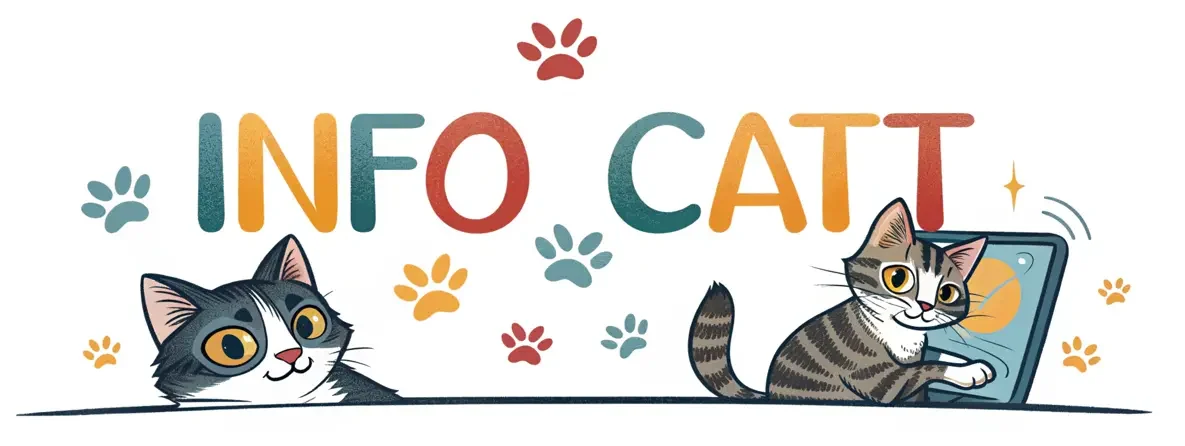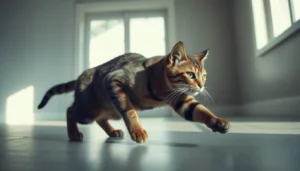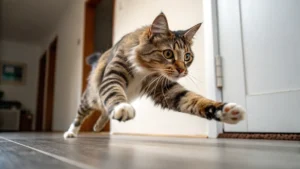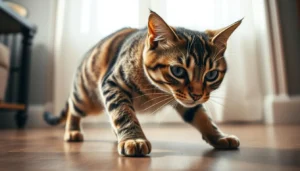Ever been surprised by a furry missile coming at you from behind the couch? If your cat has pounced on you, you’re in good company. Cat pouncing is a fascinating and sometimes puzzling part of their behavior. It makes many pet owners wonder what’s behind it.
When your cat pounces, it’s not just a random act. These playful attacks come from their natural instincts. They draw from ancient hunting behaviors that are in their DNA for thousands of years. Knowing why cats pounce can help you connect better with them and manage their energy.
Whether it’s a kitten’s playful attack or an adult cat’s sudden jump, pouncing is a complex way for cats to communicate. These moments show more about your cat’s emotional state and need for interaction than you might think.
Understanding Natural Cat Pouncing Behavior
Cat behavior shows that pouncing is a key survival skill. It’s a skill passed down through generations. Your cat’s playful jump is actually a smart hunting move.
To understand cat pouncing, we must look at their instincts. Cats are natural hunters. Their pouncing shows a set of survival skills learned from their wild ancestors.
The Evolution of Pouncing in Felines
Wild cats used pouncing to hunt. This method helps them:
- Surprise their prey
- Save energy
- Boost their hunting success
How Pouncing Relates to Hunting Instincts
Cats pounce on humans because of their hunting instincts. Even though they live with us, they still see toys or moving things as prey.
The Role of Pouncing in Cat Development
Pouncing is key for a cat’s growth. Kittens improve their coordination and hunting skills by pouncing. It also helps them build muscle and understand space.
Pouncing is more than just play—it’s a fundamental survival skill that connects your domesticated cat to its wild heritage.
Why Does My Cat Pounce On Me?
Understanding your cat’s pouncing behavior is key. It shows their natural play and body language. Cats, being predators, love to play with their humans.
Your cat might pounce on you for a few reasons:
- Expressing playful energy
- Seeking attention
- Practicing hunting skills
- Showing affection
Cat hunting instincts are behind these actions. When they jump at you, they’re acting like wild predators. It’s not aggression but a natural way to show their hunting skills.
Feline body language is important to understand. Look for:
- Dilated pupils
- Tail swishing
- Crouched posture
- Ears pointed forward
Each pounce tells a story about your cat’s emotional state and desire to interact with you. Knowing these signals can make your bond stronger. It turns random attacks into meaningful communication.
Signs That Distinguish Playful Pouncing from Aggression
Learning how cats communicate through pouncing is key. They show different emotions through pouncing, from fun to aggression. It’s important to know the difference.
Pouncing is a complex way cats talk to us. Not every pounce is the same. Spotting the differences helps avoid confusion.
Body Language Indicators During Pouncing
Your cat’s body tells you a lot about their mood. Look for these signs:
- Relaxed ears pointing forward
- Soft, dilated pupils
- Tail swishing gently
- Crouched playful stance with wiggling hindquarters
Recognizing Warning Signs Before a Pounce
Some pounces might mean your cat is upset. Watch for these signs:
- Ears pinned back or flattened
- Tail held rigid or puffed up
- Intense, fixed stare
- Growling or low-pitched sounds
Different Types of Pouncing Behaviors
Cats show different pouncing styles. Playful pounces are soft and gentle. Aggressive pounces are harder and more forceful.
Knowing these signals helps you understand your cat better. You can then react in the right way to their pouncing.
How to Respond When Your Cat Pounces
Knowing about cat territorial behavior helps you handle it when your cat pounces. Cats often chase people as a way to play or talk. It’s important to tell the difference between playful and mean pouncing to keep a good relationship with your pet.
Here’s how to react when your cat pounces:
- Redirect their energy with interactive toys
- Use a calm, firm voice to discourage aggressive behavior
- Provide plenty of mental and physical stimulation
Signs your cat loves you might include gentle pouncing to get your attention or start play. Soft paws without claws extended typically indicate a playful mood. If the pouncing gets too much, try distracting them:
- Keep a few cat toys nearby
- Gently move away from the pouncing
- Avoid using your hands as play objects
Setting clear rules helps manage your cat’s pouncing. Reward calm behavior and give them other ways to hunt. Remember, patience and positive feedback are essential to understanding and guiding your cat’s playful side.
Cats communicate through play, and understanding their signals can strengthen your bond.
Conclusion
Cat interaction with humans shows us how fascinating feline behavior is. You’ve learned that pouncing is more than just play. It’s a way for cats to communicate, rooted in their hunting instincts.
When cats pounce, they’re not just playing. They’re showing deep behaviors that connect to their wild side. Even though they live in homes, they still have those instincts. Knowing this can change how you interact with them.
By watching your cat’s body language, you can turn their pouncing into fun play. Give them toys, play together, and know when they’re being playful or not. This way, you can have a good relationship with your cat, respecting their nature while keeping everyone safe.
Every cat is different, and understanding them takes time. With what you’ve learned, you can make your cat’s life better. This will strengthen your bond with them, based on mutual respect and understanding.
FAQ
Why do cats pounce on their owners?
Cats pounce on their owners for play, communication, or to show their hunting instincts. It’s a way to get attention, release energy, or show love. They might see you as a playmate or a way to practice their hunting skills.
Is pouncing a sign of aggression in cats?
Not always. Bouncing can be playful or loving, but it depends on the situation. If it’s playful, your cat will have relaxed body language and excited energy. But if it’s aggressive, they’ll show tense body language, big pupils, and might hiss or growl.
How can I discourage my cat from bouncing too aggressively?
To stop aggressive bouncing, try these steps:
– Give lots of interactive toys
– Use play that keeps your hands safe from claws
– Set clear boundaries
– Say “no” firmly or leave play if it gets too rough
– Make sure your cat gets enough play and exercise every day
At what age do cats typically start bouncing?
Cats start bouncing as kittens, around 4-6 weeks old. This is when they learn to hunt and play. They keep practicing with their siblings and continue to play and exercise as adults.
Can bouncing be a sign of affection?
Yes, bouncing can be a sign of love. When your cat pounces playfully, it means they feel safe and want to play with you. It’s their way of saying they trust you and want to be close.
How do I know if my cat’s bouncing is normal?
Normal bouncing has soft paws, relaxed body, and playful mood. It should not show fear or aggression. If it’s too rough or often, talk to a vet or animal behaviorist.
Can indoor cats develop bouncing behaviors differently than outdoor cats?
Indoor cats pounce on toys, furniture, or people because they miss hunting. They need toys, climbing spots, and playtime to stay healthy and happy.



